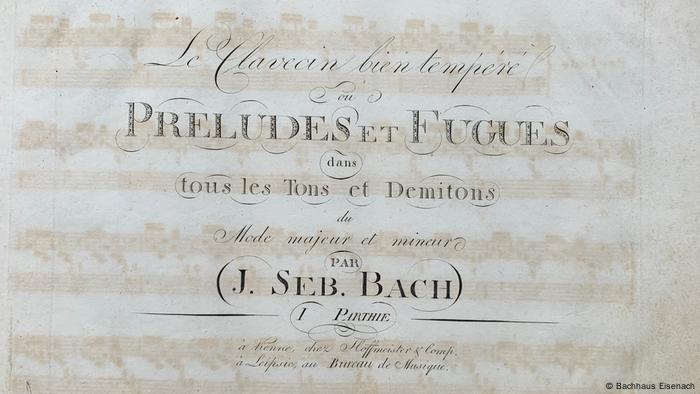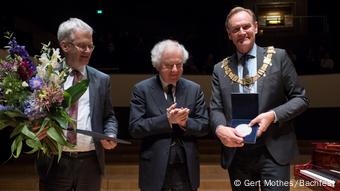One of the most influential works by Johann Sebastian Bach is celebrating its 300th anniversary this year. Pianist András Schiff played the “Well-Tempered Clavier” at the Leipzig Bach Festival.

The first sheet music of Bach's “Well-Tempered Clavier” was printed in 1801
Whether Mozart, Beethoven, Chopin or Shostakovich: they all studied Johann Sebastian Bach's “Well-Tempered Clavier”. 300 years ago, Bach published what is probably the most influential piano work in music history. “That was part of the musical knowledge that you had to know. Robert Schumann called it 'the work of all works,'” says Michael Maul, director of the Leipzig Bach Festival in an interview with DW.
To this day, prospective pianists worldwide are perfecting their piano playing with the Well-Tempered Clavier. Johann Sebastian Bach composed 24 preludes and associated fugues in all major and minor keys from C major to B minor for this “exercise book”, “for the benefit and use of musical youth eager to learn”, as he writes in the explanation. “I love her dearly,” says the Hungarian pianist András Schiff. “The Prelude and Fugue in B minor are simply colossal. As a performer you feel very modest and grateful.”
Bach Medal for András Schiff
In the Leipzig Gewandhaus, Schiff played all 48 pieces from the first part of the “Well-Tempered Clavier” and was greeted with standing ovations. As a master of the unusual Bach interpretation, he subsequently received the Bach Medal of the City of Leipzig, an award for special services to the cultivation of Bach's work. “His subtle playing on the modern grand piano is both a benchmark and an inspiration for every pianist who deals with Bach,” says the certificate. Schiff is known for his unusual interpretations and accentuations, with which he creates new sound experiences of well-known pieces.

András Schiff (centre) receives the Bach Medal from Mayor Burkhard Jung (right) and Peter Wollny (left)
“Unfortunately, I have no talent for composing, but when you know what makes a great composer like Bach, you also know what not to do, which is to compose mediocrely,” Schiff said in his acceptance speech. The next best thing is therefore to become a good Bach interpreter. “I will continue to play Bach on the clavichord in my living room every day,” said the 68-year-old, expressing his wish for peace in view of the “terrible war” in Ukraine.
Art the “beautiful” instrument tuning
Bach's son Carl Philipp Emanuel Bach wrote in a 1754 obituary to his father that he understood how to temper his harpsichord “in the mood so pure and correct that all keys sounded beautiful and pleasing.” In the 17th and 18th centuries, many scientists dealt with the tuning of western instruments.
Watch the video 02:26
Michael Maul explains: Bach's “Well-Tempered Clavier”
The distance between the different tones within a key was not regulated as uniformly as it is today. “Today, instruments are tuned in such a way that there really is a semitone between each note, and that can be checked electronically,” explains Bachfest director Michael Maul. This also makes it possible to perform all 24 preludes and fugues of the Well-Tempered Clavier in one piece.
It used to be different. If you tuned a harpsichord so that it sounded “pure” and pleasing in a certain key, then a piece in a different key with the same tuning could sound pretty weird. Theoretically, you had to tune the instrument differently for each key you wanted to play, and within a composition you could only combine certain keys that harmonized tonally.
Bach's “old testament” for pianists
In Eisenach, where Bach was born in 1685, from July 1st an exhibition in the Bach House will pay tribute to his “Well-Tempered Clavier” under the title: “The Old Testament of the Piano Players – 300 Years of Bach's Well-Tempered Clavier”. With the help of a midi station, a synthesizer, you can recreate the moods that were common at the time.

Director of the Bachhaus, Jörg Hansen, lets Bach's “Well-Tempered Clavier” sound in different moods
One of them is the “well-tempered tuning” designed by the theorist and organist Andreas Werckmeister in the 17th century. “With the Well-Tempered Clavier, no key is purely tuned and that's the highlight, it's a compromise that allows all keys to be played,” explains Jörg Hansen, director of the Bachhaus in Eisenach. “I distribute the impurities so that no one notices”. According to Hansen in an interview with DW, that gave composers the freedom to compose without restrictions. No one knows exactly how far Bach stuck to Werckmeister's “Well-Tempered” tuning or developed his own tuning.
The Well-Tempered Clavier Part II
20 years after the “Well-Tempered Clavier” Part I, Johann Sebastian Bach composed another 24 preludes and fugues for the second volume. An even larger work performed by the Canadian pianist Angela Hewitt at the Leipzig Bach Festival.
Jörg Hansen selected the recordings of the first part in the recording by Angela Hewitt as audio samples for his exhibition. You can hear them through 24 headphones hanging from colored bars. An allusion to the fact that Bach might have started composing his “Well-Tempered Piano” in prison. “The room with the bars has the character of a prison where people who were influenced by Bach look in,” including photos of Dmitri Shostakovich, who wrote 24 preludes and fugues and repeatedly quoted Bach musically, or Alexander Scriabin, who also read 24 preludes through all composed keys and also designed colors.

View of the Bastille Weimar, where Johann Sebastian Bach 1717 sat in prison.
The Well-Tempered Clavier composed in prison?
In 1717, Bach was actually imprisoned in Weimar prison for four weeks. He had signed a contract as Kapellmeister in Köthen without first asking his employer in the correct form for permission and his dismissal from the Duke of Weimar. The “stubborn” concert master and court organist Bach was released from prison after four weeks in disgrace and also from his position and then took up his position in Köthen.
The music lexiconographer Ernst Ludiwg Gerber reported in 1790 that Bach composed the Well-Tempered Clavier “in a place where displeasure, boredom and a lack of any kind of musical instruments made this pastime compulsory for him”. This could have been the prison cell, but the exact location is not given. “Another theory leads to Karlsbad”, says Jörg Hansen, “he was there in 1720 with the court orchestra and Prince Leopold and could have been bored when the gentlemen drank water and bathed there.”
Bachs leading musical work for the western world
While Bach's passion works and cantatas initially lost their importance after his death, his organ and piano works set standards over the centuries. The pianist and composer Hans von Bülow described the “Well-Tempered Clavier” as “the Old Testament of the pianist”.
Bach's composition is used as an exercise book by piano students all over the world. “It influenced the idea of the relationship between keys,” says Jörg Hansen. In this way, the work became formative for the music of the western world. “It's the guiding principle of our idea of classical music.”
Watch video 06:03